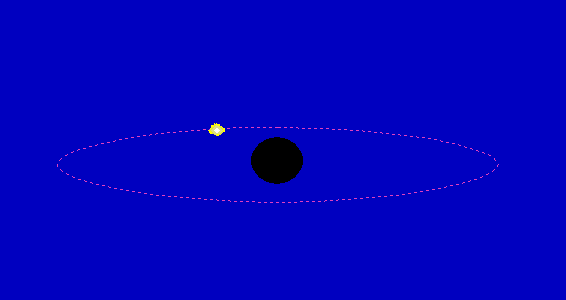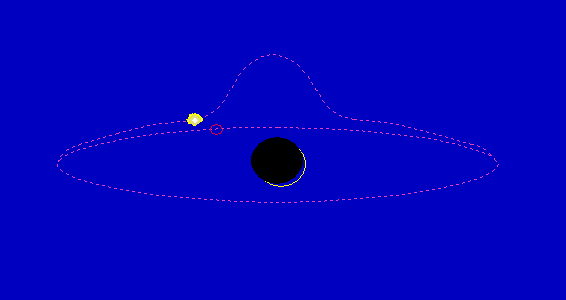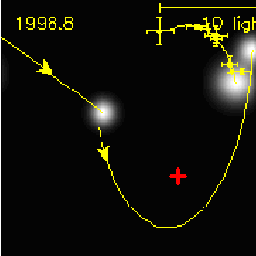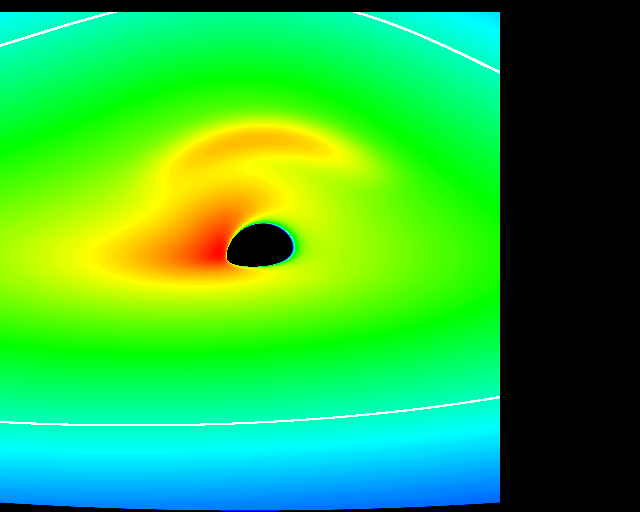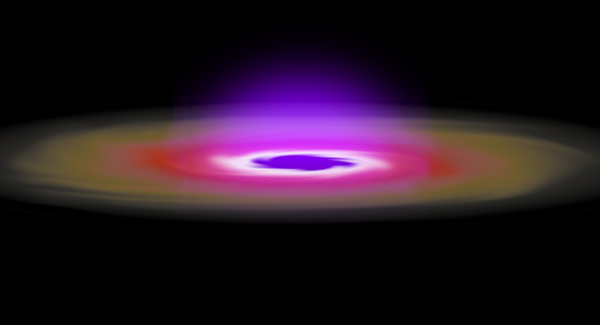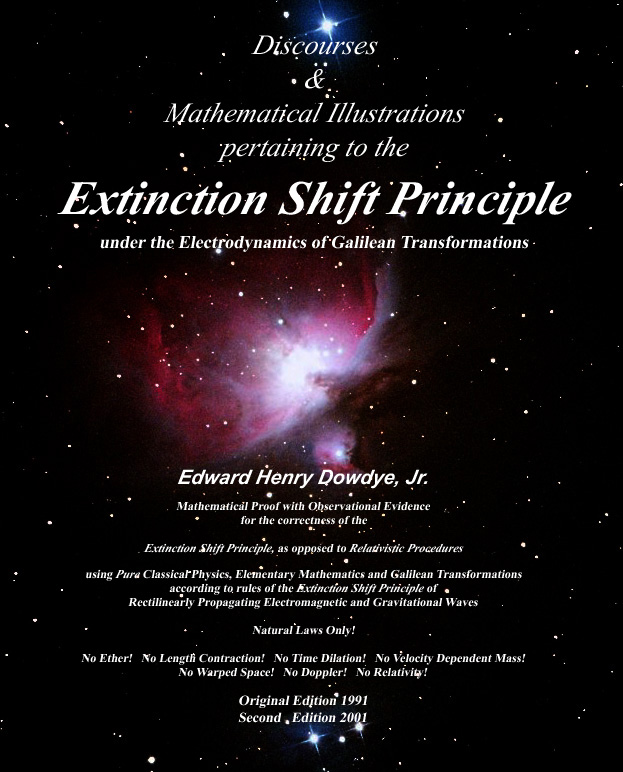Significant Findings�
A Direct Interaction Between Light and Gravitation Does Not Occur
Convincing Astrophysical Evidence at the Galactic Center
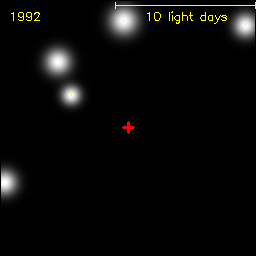
Fig 9 Undistorted time resolved images of stellar objects orbiting about Sagittarius A*
recorded processed images collected from 1992 to 2006
by
Max-Planck-Institut f�r extraterrestrische Physik
For details:
An Astrophysical Experiment that Relativity apparently Fails
under intense observations since 1992
|
|
|
Fig 10A Star orbits a black hole showing no lensing effects AS OBSERVED AT THE GALACTIC CENTER |
|
|
|
Fig 10B A Star orbits a black hole exhibiting gravitational lensing as predicted by the Light Bending Rule of General Relativity as presented in the Textbooks, Literature and Lectures OBSERVED NOWHERE IN HISTORY OF ASTROPHYSICS |
| The recorded time resolved
movie images in Figure 9 and the animation of the star orbiting about
the black hole
in Figure 10A depict
the reality of what is currently being observed in modern Astrophysics and Astronomy
today.
The animation of the star orbiting about the black hole illustrated in Figure 10B is a typical textbook depiction of what is predicted by the light bending rule of General Relativity. It is important to note that this is typically presented in most textbooks, in the literature and in virtually all lectures dealing with the subject matter of Gravitational Lensing as predicted by the light bending rule of General Relativity. |
|
Sagittarius A* Astrophysical Orbital Data for S2 & S14 |
||||||
| Star Label | Impact Parameter ξ | Gravitational Deflection α | ||||
| (light time) | (meters) | (AU) | (radians) | (degrees) | (arcsec) | |
|
S14 |
6 Lhours* | 6.47553E+12 | 43.29 | 3.64949E-03 |
0.209100573 |
752.762062 |
|
S2 |
17 Lhours* | 1.83473E+13 | 122.65 | 1.28806E-03 | 0.073800202 | 265.680728 |
| S2 | 5.5 Ldays | 1.42462E+14 | 952.30 | 1.65886E-04 | 0.009504571 | 34.2164573 |
| S2 | 10 Ldays | 2.59021E+14 | 1731.46 | 9.12373E-05 | 0.005227514 | 18.8190515 |
* Nearest Point of Approach to Black Hole
Table: Gravitational Deflection as function of Impact Parameter
as Predicted by the Light Bending Rule of General Relativity

|
||||
| Figure 11 An Animation of a Textbook Depiction of Gravitational Lensing at Sagittarius A* | ||||
| (Note: This is a textbook depiction that is not yet observed in all modern Astrophysics.) | ||||
| The astrophysical events taking place at Sagittarius A* might appear as such | ||||
| if the Light Bending rule of General Relativity actually applied | ||||
| (showing time resolved images from 1998.8 to 2003.2) |
|
The above illustrations depicted in Figures 10B and 11 are animations of gravitational lensing as predicted by the light bending rule of General Relativity and as presented in the textbooks, in the literature and in the lectures. For a gravitation mass of 4 million times Msun (the galactic mass of Sagittarius A*) at the same impact parameter, a gravitational deflection for the light ray would be α = (1.75/214) x 4*10^6 = 32710 arcsec or α = 9.08 degrees. This would be a very noticeable lensing effect for modern astronomical means. It is also interesting to note that the orbiting stars denoted as S2 and S14 have highly elliptical orbits with orbital periods of 15.24 and 38 years respectively. Also note that the nearest point of approach in the orbits of S2 and S14 to the perceived black hole occurred at 2002.315 and 2000.156 respectively. This double event occurred to within 2.159 years apart from one another; a back-to-back event. This will not occur again for another 76 years and 152 years, when the nearest point of approach is predicted to occur to within 3 years of one another, assuming correctness of the orbital periods of these stars. Either a missed opportunity occurred during the observation of this back-to-back gravitational lensing event or this gravitational lensing effect, as is predicted by the light bending rule of General Relativity, simply does not occur. To date there has been no evidence of a gravitational lensing effect as can be detected from the broad band emissions of electromagnetic waves coming from the stellar objects orbiting about Sagittarius A*. The emissions that permit the astrophysicists to track these stellar objects, moving strictly according to Kepler's laws about Sagittarius A*, lie predominantly in the ultraviolet, x-ray and gamma-ray regions of the electromagnetic spectrum. All these emissions, however, are theoretically subjected to the very same light bending rule of General Relativity. An evidence of gravitational light bending at the site of Sagittarius A*, as is predicted by the light bending rule of General Relativity, is yet to be observed; an area under intense observations by modern Astrophysics since its discovery in 1992. It is interesting to note that only in the movies and in the animated illustrations do these gravitational lensing scenes occur; all of which are merely artist depictions of how such an events might appear to the modern astrophysical or astronomical observers. Some examples are as follows:
The academic textbooks are filled with artist impressions pertaining to gravitational lensing effects similar to the above depicted illustrations. From the important fundamentals of Physics delealing with this subject, having gone through Topics 1 to 7, a final conclusion should be easily made herewith. CONCLUSION There is no astronomical or astrophysical evidence for a time resolved gravitational lensing event resembling any of the above artist depicted illustrations and animated representations thereof.
|
||||||||
|
|
||||||||
|
The very tip-off that led to these findings on gravitational lensing was first published in the original 1991 edition and the 2001 edition of this book: Discourses & Mathematical Illustrations pertaining to the Extinction Shift Principle under the Electrodynamics of Galilean Transformations The book contains the complete set of problems responsible for the success and fame of Relativity, worked out in Euclidean Space solely under Galilean Transformations of velocities. The Principal Axioms of the Extinction Shift Principle correctly predicts the experimental outcome of important experiments of the past century. Astrophysical phenomena such as the planet Mercury and the PSR1913+16 neutron pulsar system perihelion rotation effects are calculated using pure classical procedures in Euclidean space. For the very first time the gravitational deflection of light in the solar plasma atmosphere was derived from a energy conservation assumption that an electromagnetic wave will propagate along a minimum-energy or a least-time path in a plasma atmosphere exposed to the gravitational gradient field of the sun. The Extinction Shift Principle predicts there can be NO direct interaction between Gravitation and Electromagnetism Details: http://www.extinctionshift.com/details.htm how to get books: click below on the book |
